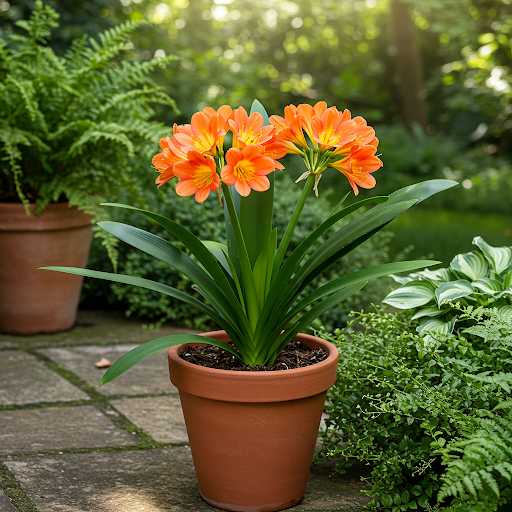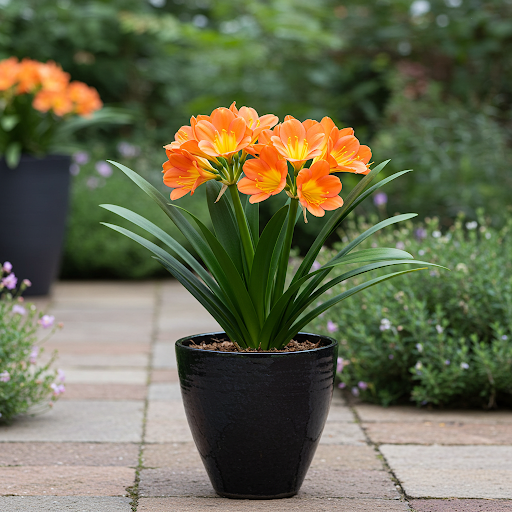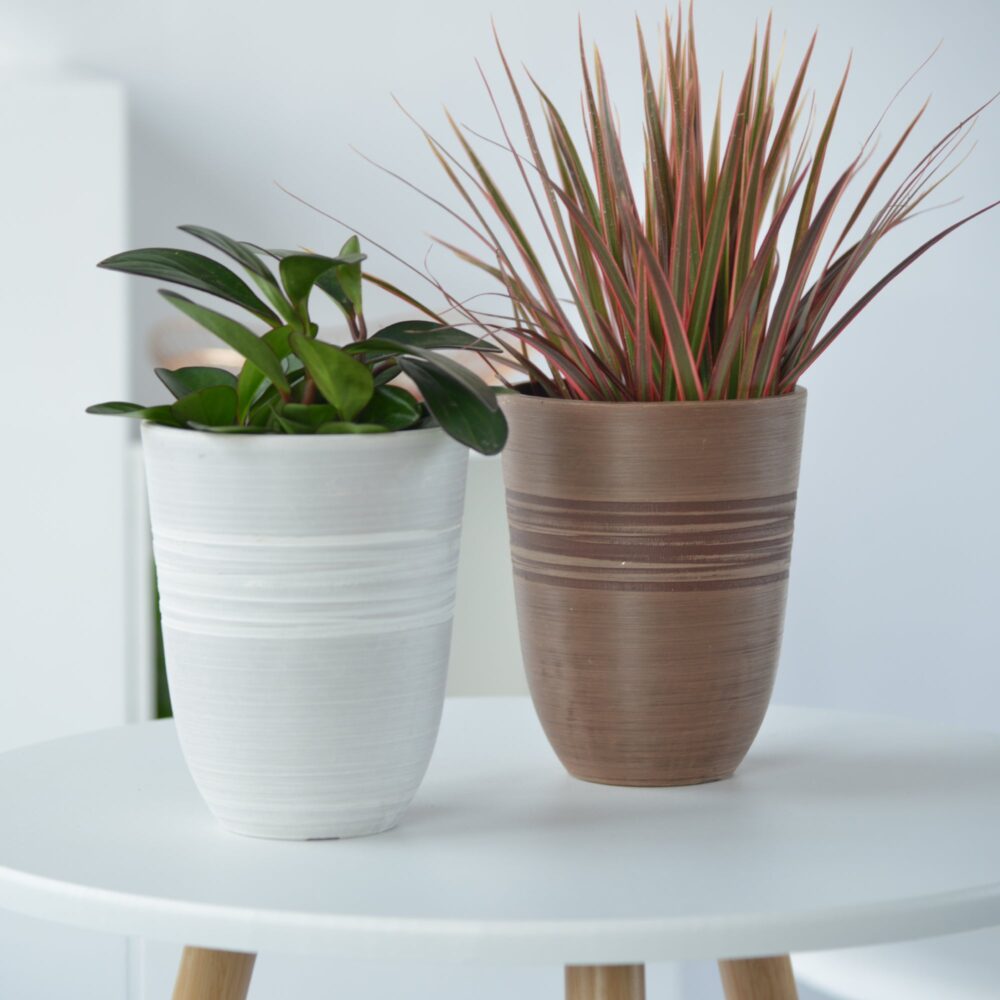Clivia in Pots: The Complete Guide to Growing Bush Lily Outdoors in Containers (Spectacular Blooms!)
Want to add a touch of exotic elegance and vibrant color to your patio, balcony, or garden? Growing Clivia (Clivia miniata) in containers is a wonderfully rewarding way to bring these striking flowering plants into your outdoor spaces. Celebrated for their clusters of trumpet-shaped, vividly colored flowers, their strappy, evergreen foliage, their shade tolerance, and their adaptability to container gardening, Clivia (also known as Bush Lily or Kaffir Lily, and 君子兰 in Chinese) is perfect for adding a touch of sophistication and bold color to your outdoor living areas, especially in shaded or partially shaded locations. This comprehensive guide will provide you with everything you need to know to grow Clivia miniata successfully in outdoor pots, from selecting the best plants and containers to mastering essential care techniques for a spectacular and long-lasting floral display.

Clivia
What is Clivia (Bush Lily)?
Clivia, scientifically known as Clivia miniata, is a popular evergreen flowering perennial belonging to the Amaryllidaceae family (the Amaryllis family).1 Native to subtropical forests of South Africa, they are widely cultivated as ornamental plants, both indoors and outdoors, prized for their showy, trumpet-shaped flowers, attractive, strappy foliage, shade tolerance, and relative ease of care.2 Clivia plants are characterized by their dark green, strap-like leaves that arise from a bulb-like base (though they are technically stemless herbaceous plants with rhizomes), and upright stalks bearing clusters of vibrant, trumpet-shaped flowers.3 Flowers typically bloom in shades of orange, red, yellow, and peach, and are followed by red berries. They exhibit a clumping, upright growth habit, typically reaching heights of 1-2 feet and spreading 1-2 feet wide, making them well-suited for pots and shaded garden areas. They are known for their striking floral displays, shade tolerance, evergreen foliage, and adaptability to container culture, making them a popular choice for homes, patios, balconies, shaded gardens, and courtyards, especially for adding bold color and architectural foliage to shadier locations. In Chinese culture, it is known as 君子兰 (Jūnzǐlán), meaning “noble person’s orchid,” reflecting its elegant and refined appearance.
Is Clivia (Bush Lily) Good for Outdoor Pots?
Yes, Clivia is exceptionally well-suited for outdoor pots and container gardening, and is a popular choice for adding color and lush foliage to shaded patios, balconies, and other outdoor areas. Their shade tolerance, manageable size, attractive foliage, and adaptability to pot culture make them ideal for container gardens. Growing Clivia in pots offers several advantages:
- Excellent Shade Tolerance: Clivia thrives in partial to full shade, making it perfect for shaded patios, balconies, and north-facing gardens where many other flowering plants struggle.4
- Portability: Potted Clivia can be easily moved to optimal locations for light and temperature, or to create seasonal displays. You can bring them to more sheltered spots during heavy rain or extreme weather.
- Controlled Environment: Container gardening allows you to provide the well-draining, humus-rich soil mix that Clivia prefers and control watering and fertilization precisely, which is important for their specific needs.
- Design Versatility: Clivia works beautifully as a standalone specimen plant in a decorative pot, or as part of mixed shade-tolerant container arrangements, adding bold color and architectural foliage.
- Pest and Disease Management: Container growing can help reduce some soilborne pest and disease issues that can affect Clivia planted directly in the ground.
- Ideal for Shaded Patios and Balconies: Clivia in pots is perfect for adding a touch of tropical elegance to shaded patios, balconies, courtyards, and other outdoor living spaces that don’t receive full sun.
- Cold Climate Flexibility: In regions with colder winters, potted Clivia can be easily moved indoors to a bright, cool location to protect them from frost and freezing temperatures, and then brought back outdoors in warmer months to enjoy their blooms. (Though this is not strictly necessary in Singapore, moving them to a sheltered spot during very heavy rain might be beneficial).
Ideal Growing Conditions for Clivia (Bush Lily) in Pots:
Light: Clivia thrives in partial to full shade.5 When grown outdoors, they appreciate a location that receives bright, indirect light or dappled shade throughout the day. Avoid direct, harsh sunlight, especially during the hottest part of the day, as this can scorch their leaves.6 A location with morning sun and afternoon shade, or filtered light all day, is ideal. East-facing or north-facing patios or balconies, or spots under trees that provide dappled shade, are often excellent locations. While they tolerate deep shade, flowering may be reduced in very dark conditions. Bright, indirect light is optimal for best flowering and foliage color.
Soil: Clivia needs well-draining soil that is rich in organic matter and slightly acidic.7 Use a high-quality potting mix specifically formulated for indoor plants, flowering plants, or even orchids. Amend potting mix with peat moss, orchid bark, composted bark, or perlite to improve drainage and aeration while retaining some moisture and richness. Good drainage is essential to prevent root rot, which Clivia can be susceptible to if soil is waterlogged.8Avoid heavy, compacted soil. A slightly acidic to neutral pH (around 6.0-7.0) is ideal.9
Watering: Clivia prefers consistent moisture during its active growing and blooming season, but dislikes soggy conditions.10 Water thoroughly when the top inch of soil feels slightly dry. Water deeply until water drains out of the drainage holes. Then, allow the topsoil to slightly dry before watering again. Avoid overwatering and consistently soggy soil, which can lead to root rot.11 Also, avoid letting the soil dry out completely, especially when plants are actively growing and blooming. Clivia prefers a “moist but not waterlogged” soil environment.12Watering frequency will depend on weather conditions, light levels, and pot size. Water more frequently during warmer, drier periods and less frequently during cooler, cloudier periods. Reduce watering significantly in the dormant season (after flowering, typically in late summer and fall). Allow the soil to become drier during dormancy to encourage flower bud formation for the next blooming season.
Temperature: Clivia thrives in moderate temperatures, ideally between 60-75°F (15-24°C) during the growing season.13 They are subtropical plants and are not frost-hardy.14 In Singapore’s consistently warm climate, temperature is generally suitable for Clivia year-round, although they appreciate slightly cooler temperatures during their dormancy period to encourage flowering. Avoid prolonged exposure to temperatures below 40°F (4°C) or above 90°F (32°C). Consistent moderate temperatures are beneficial for their growth and flowering. A cooler, drier period in fall can help initiate flower buds.
Humidity: Clivia prefers moderate to high humidity, reflecting their subtropical forest origins. Singapore’s humidity is generally well-suited to Clivia. They appreciate humidity and good air circulation.
Fertilizer: Clivia benefits from regular fertilization during the active growing and blooming season to support healthy growth and abundant flowering.15 Fertilize every 2-4 weeks during the spring and summer growing season. Use a balanced liquid fertilizer (e.g., 20-20-20 or 10-10-10) diluted to half strength, or a fertilizer specifically formulated for flowering plants or orchids.16 Follow product label instructions for application rates. A fertilizer slightly higher in phosphorus (the middle number) can encourage better flowering. Reduce or stop fertilizing during the dormant season (late summer and fall) when plant growth naturally slows down.
Choosing the Right Pots for Clivia (Bush Lily):
Suitable Pot Types: Clivia can be grown in various pot types, but good drainage and appropriate size are important. Terracotta pots are often recommended. Suitable pot types include:
- Terracotta Pots: Terracotta is often considered an excellent choice for Clivia. It is porous, allowing for good aeration and drainage, which is beneficial and helps prevent overwatering. Terracotta also provides a classic, natural look.
- Ceramic Pots: Unglazed or glazed ceramic pots can be used. Ensure they have drainage holes. Choose based on your desired aesthetic and pot size needs.
- Resin Pots: Lightweight, durable, available in styles mimicking terracotta or ceramic, and offer a balance of drainage and moisture retention. Resin pots are a good alternative to heavy ceramic or terracotta.
- Plastic Pots (with caution): Plastic pots can be used, but they retain more moisture than terracotta. If using plastic, be extra vigilant about watering and ensure the potting mix is very fast-draining.
Drainage: Good drainage is essential for Clivia to prevent root rot.17 Ensure your chosen pot has drainage holesat the bottom. Avoid pots without drainage holes. Adding a layer of drainage material at the base of the pot (e.g., a layer of gravel, pot shards, or clay pebbles) is recommended to further improve drainage. Elevating pots slightly on pot feet or bricks can also improve drainage and air circulation.18
Pot Size: Clivia prefers to be slightly pot-bound to bloom well.19 Choose pot sizes that are only slightly larger than the root ball. Avoid overpotting.
- Starting Size (Young Plants): For young Clivia plants, start with a pot that is only slightly larger than the root ball, perhaps 1-2 inches larger in diameter. For example, if the plant is in a 6-inch pot, repot into an 8-inch pot.
- Mature Size (Established Plants): For mature Clivia plants, choose pots that are only slightly larger than the root ball. They do not need large pots. A 8-12 inch pot is often sufficient for a mature plant. They bloom best when roots are somewhat confined.
- Depth: Pots should be at least 8-10 inches deep to accommodate the root system.
Stability: Clivia plants are generally not very top-heavy, but using moderately heavy pots (terracotta or ceramic) can provide good stability, especially for larger, mature plants or if placed in slightly windy locations.
Color and Style: Choose pot colors and styles that complement the vibrant flower colors and rich green foliage of your Clivia and your outdoor décor, and enhance their elegant, tropical appearance. Earthy tones like terracotta, brown, beige, or muted greens can enhance the natural, lush look. Darker pots in shades of green, black, or charcoal can create a sophisticated contrast and make the flower colors pop. Consider the overall style of your patio or balcony and choose pots that harmonize with the surroundings and enhance the desired elegant, shade garden ambiance.
Essential Care Tips for Thriving Clivia (Bush Lily) in Outdoor Pots:
- Watering: “Keep Soil Moist During Growing Season, Drier During Dormancy”. Water thoroughly when the top inch of soil is slightly dry during the growing season (spring/summer). Water deeply and ensure good drainage. Allow topsoil to slightly dry between waterings. Reduce watering significantly during dormancy (late summer/fall).
- Light: Provide Partial to Full Shade. Avoid Harsh Direct Sun. Place Clivia pots in a location with partial to full shade outdoors. Protect from direct, intense sunlight. Bright, indirect light is ideal.
- Temperature: Maintain Moderate Temperatures (60-75°F/15-24°C) During Growing Season. Provide moderate temperatures. Protect from extreme heat and frost. A cooler, drier period in fall helps initiate flowering.20
- Fertilizing: Fertilize Every 2-4 Weeks During Growing Season with Balanced Liquid Fertilizer. Fertilize regularly during the spring and summer growing season to promote healthy growth and flowering. Use a balanced liquid fertilizer. Reduce or stop fertilizing during dormancy.
- Repotting (Only When Root-Bound, Every Few Years): Repot Clivia only when they become significantly root-bound, typically every 2-3 years or longer.21 They bloom best when slightly pot-bound, so avoid frequent repotting.22 Repot in spring after flowering.
- Dormancy Period (Cooler, Drier Rest in Fall): Clivia needs a cooler, drier dormancy period in late summer and fall to initiate flower buds for the next blooming season.23 Reduce watering and fertilization during this time and provide slightly cooler temperatures if possible.
- Deadheading (Optional, for Neatness): Deadheading spent flowers is not strictly necessary, but you can remove faded flower stalks for a tidier appearance and to prevent seed formation, which can divert energy from future blooms.
- Pest and Disease Control: Clivia is relatively pest and disease resistant. Monitor for common pests like mealybugs or spider mites, though they are not usually a major problem outdoors. Root rot is the most common disease issue, caused by overwatering. Prevent root rot by ensuring excellent drainage and proper watering practices.
Popular Clivia Cultivars (and Flower Colors & Forms):
Clivia cultivars are available in a range of flower colors, sizes, and forms beyond the typical orange.24
- Flower Colors: Orange (classic), Red, Yellow, Peach, Cream, Apricot, Bi-colors.
- Flower Forms: Trumpet-shaped (most common), bell-shaped, spider-type (narrow petals).
- Foliage Variations: Some cultivars have wider leaves, different shades of green, or variegated foliage.
- Miniata Hybrids: Most common type, includes classic orange and many color variations.
- Clivia nobilis: Pendulous, narrow, greenish-orange flowers, different flower shape from miniata.
- Clivia gardenii: Pendulous, orange flowers, blooms later than miniata.
- Belgian Hybrids: Known for large flower heads and wide range of colors.25
- Kirstenbosch Hybrids: Bred in South Africa, often heat-tolerant.
In Summary:
Growing Clivia (Clivia miniata) in outdoor pots is a wonderfully rewarding way to add a touch of exotic elegance and vibrant color to shaded areas of your patio, balcony, or garden. Their striking trumpet-shaped flowers, attractive foliage, and shade tolerance make them a perfect choice for container gardeners of all levels, especially those seeking bold, low-maintenance color for shadier locations. By providing partial to full shade, well-draining, humus-rich potting mix in pots with good drainage, keeping the soil consistently moist during the growing season but drier during dormancy, regular fertilizing during spring and summer, and allowing for a cooler, drier fall dormancy period, you can easily cultivate thriving and spectacularly blooming Clivia plants in pots and enjoy their dramatic floral display in your outdoor living spaces year after year.

Clivia
For more detailed botanical information and to explore the diverse world of Clivia miniata (Clivia), you can visit the Wikipedia page on Clivia miniata.
Important Note: Clivia thrives in shade and prefers to be slightly pot-bound for best flowering.26 Avoid overwatering and provide a cooler, drier dormancy period in fall to encourage abundant blooms in the spring.27 With proper care and a shaded location, your potted Clivia will reward you with years of elegant foliage and stunning floral displays!
20VD
By greenship|2024-08-13T06:43:41+00:00August 13, 2024|Categories: Hand-carving Series|
20T
By greenship|2024-08-13T06:42:22+00:00August 13, 2024|Categories: Hand-carving Series|
KC3-14A
By greenship|2024-08-16T06:26:30+00:00August 16, 2024|Categories: Hand-carving Series|
11TH
By greenship|2024-08-13T02:50:25+00:00August 13, 2024|Categories: Hand-carving Series|
Plant Pots 6 inch 8 inch 10 inch for Indoor Plants, Set of 3 Modern Decorative Planter ts with Drainage Hole, Decorative Flower Pots
By greenship-seo|2025-04-10T06:39:28+00:00January 14, 2025|Categories: Hand-carving Series|Tags: Decorative Flower Pots|
KC2-11V
By greenship|2024-08-16T05:39:50+00:00August 16, 2024|Categories: Hand-carving Series|






